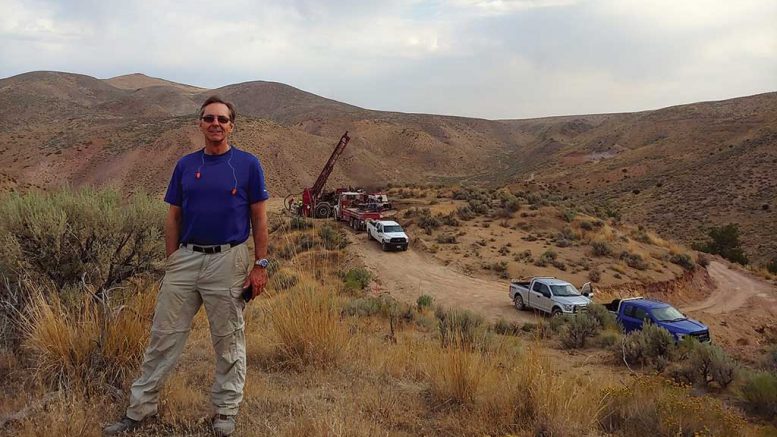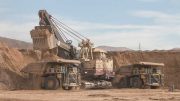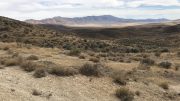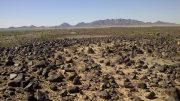In mid-2018, First Vanadium (TSXV: FVAN; US-OTC: FVANF) drilled 69 reverse-circulation holes as part of the phase-two drilling program at its Carlin vanadium project, 9.6 km south of Carlin, Nevada.
Of those, 33 were step out holes and 36 were infill holes. The company recently reported results from 10 of those step-out holes.
The drilling focused on a 220-by-300-metre area and connected shallow, near-horizontal mineralization from the nearest drill holes. Highlights include 32 metres grading 0.81% vanadium oxide (V2O5) from 9 metres downhole, 27.5 metres at 0.44% V2O5 from 6 metres downhole, and 15.2 metres at 0.45% V2O5 from 15.2 metres downhole.
The project is now defined by 216 holes from First Vanadium’s mid- and late-year drill programs, as well as Union Carbide’s 1960s drilling.
Union Carbide drilled 127 holes.
“In those days the only metallurgical procedure was a roast, and they could only get 50% out,” First Vanadium president and CEO Paul Cowley says in an interview with The Northern Miner. “Over time the claims expired.”
SRK Consulting calculated a National Instrument 43-101-compliant resource based on the historical Union Carbide drilling in 2010.
The Carlin vanadium project has a historic resource of 28 million inferred tonnes grading 0.51% V2O5 for 289 million lb. V2O5.
The claims would change hands a few more times before First Vanadium picked them up. At the time the company was called Cornerstone Metals. It changed its name to First Vanadium in September 2018.
A subsidiary of Golden Predator Mining (TSXV: GPY; US-OTC: NTGSF) owns the claims. The private company, America’s Gold Exploration, assigned its option to acquire a 100% interest in the property to First Vanadium in November 2017.
To earn its interest, the company must spend US$1.02 million exploring the property over the next six years. It would make staged payments to America’s Gold totalling US$1.97 million, with more payments of US$250,000 per year after a preliminary economic assessment. It would also issue 2 million shares.

First Vanadium drilled its Carlin vanadium project twice in 2018 and plans to release a resource estimate for the project early in 2019. Credit: First Vanadium.
The company has already paid America’s Gold US$60,000 and issued 1 million shares. If First Vanadium acquires its 100% interest, America’s Gold will be granted a 1.5% net smelter return royalty (NSR) that First Vanadium can buy back for US$1 million. Golden Predator will be granted a 2% NSR that First Vanadium can buy back for US$4 million.
Starting in late December 2017 and continuing through early 2018, First Vanadium drilled 1,600 metres across 20 infill holes at Carlin. Results from that program include 47.5 metres at 1.08% V2O5 from 28.5 metres downhole and 36 metres at 1.09% V2O5 from 51 metres downhole.
“We were just drilling to make sure the deposit was there,” Cowley says. “But we could see that very inexpensively we could make the deposit bigger and infill areas to make sure that we get as much indicated resources as possible, so that’s why we ended up doing another drill campaign in August and September.”
The project consists of 72 claims covering 4.6 sq. km in Elko County, and can be accessed by road from Elko and Carlin.
It’s located on the western flank of the Pinon Range, a block-faulted host of the Basin and Range tectonic province. The local lithologies are mostly Paleozoic age, western assemblage and siliceous rocks above the Roberts Mountain Thrust.
The company has modelled a 55-metre-thick vanadium zone striking north to south over 1,900 metres. It dips between 5 and 30 degrees west for an average 760 metres of down-dip extent from surface. It mostly occurs between 15 and 60 metres from surface.
First Vanadium aims to update the resource estimate in January 2019 and begin work on a prefeasibility study shortly after.
“In the last year, vanadium has outperformed all other metals, and it’s just kind of the right time and right place for the right project,” Cowley says.
The price of vanadium in China, for example, has risen from under US$3 per lb. V2O5 three years ago to over US$33 per lb. V2O5.
“In the past when vanadium prices did go up very shortly, a high-cost mine in China would restart and drive the price down,” Cowley says. “Because the Chinese government is now taking a hard line on pollution, it has permanently shut down that high-cost, polluting mine.”
According to Paul, 90% of vanadium goes into structural steel. He says Russia, China and the U.S. have trillions of dollars of infrastructure that are on the books for the near future that will need vanadium. Electric car batteries also have vanadium, although in smaller quantities, as do car chassis.
“There’s also a Chinese legislation that just took effect the first of November that all the rebar manufacturers need to put 30% more vanadium in the rebar, because they were producing low-quality rebar and buildings were collapsing,” Cowley adds. “They’re going to have inspectors with X-ray guns testing this rebar before they can deploy it into buildings and bridges, and the like.”
Shares of First Vanadium are trading at $1.39 in a 52-week range of $1.20 to $1.96. The company has a $46-million market capitalization.
It also has its West Jerome copper property in central Arizona, although for now it is focused on Carlin.
“As a gold analogy, Carlin is the equivalent of an 8 million oz. gold deposit,” Cowley says. “That’s the value of this thing. And it’s at a very high grade. If you keep everything the same, and you just substitute metal prices for vanadium versus gold, that’s basically an 8 million oz. gold deposit at 8.5 grams.”






Be the first to comment on "First Vanadium pushes Carlin toward updated resource"